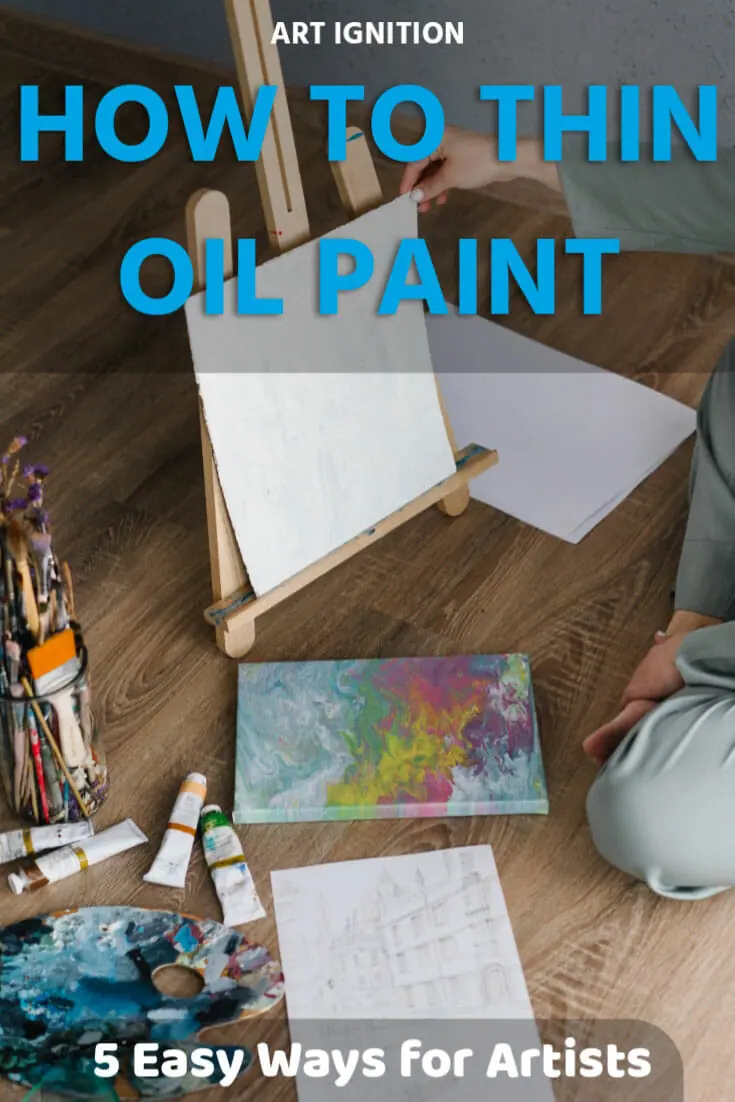There’s an art to oil painting – and there’s also a science.
When first learning how to thin oil-based paint for brushing, many new artists panic about the science behind the process.
If you’re unsure how to thin oil paint, we’re here to guide you! Below you’ll find out the basics of paint thinners and how to use them to enhance your creative process.
Sure, learning how to thin oils can take time – but we’ll show you how it can be experimental and low-stress.
What Are the Types of Paint Thinners for Oil Painting?
To make oil paint thinner, you can mix it with solvents, oils, mediums, and gels. Below you’ll find the common types of paint thinner and which products may work best for you.
Material
Type
Purpose
Additional Notes
Chemical solvent
Thins oil paints and cleans paintbrushes
- Made from pine tree resin
- Strong odor
- Dries matte
Chemical solvent
Thins paint and cleans oil paintbrushes
- Made from petroleum oil
- Dries matte
Turpentine substitute
Cleans oil paintbrushes
- Best for cleaning brushes; if used as a solvent, can discolor the paint
Less toxic solvent
Thins paint and can be used to blend colored pencils
- 100% non-toxic
- Lavender smell
- Dries matte and at a similar rate as turpentine
Less toxic solvent
Thins paint
- Artist-grade odorless mineral spirit (OMS)
- Weaker than traditional mineral spirits
- Dries matte
Less toxic solvent
Thins paint and cleans oil paintbrushes
- Easily disposable
- Dries matte
- Natural alternative to mineral spirits
Medium
Changes viscosity (thickness and flow) of oil-based paints, adds gloss and slows drying
- Can be mixed with solvents
- May change hue of paint
- Dries glossy
Medium
Changes viscosity, adds gloss, and slows drying
- Increases gloss, flow, and transparency
- Works well with white and pale colors
Medium
Changes viscosity, adds gloss, and slows drying
- Adds sheen and flexibility to paint surface
- Non-yellowing
Medium
Changes viscosity, adds gloss, and slows drying
- Leaves an enamel-like finish
- Thickest of the natural oils
Medium
Changes viscosity, adds gloss, and slows drying
- Fast-drying
- Works well with white and pale colors
Alkyd medium
Speeds drying and improve gloss
- Available in five different thicknesses
- Dries glossy
Gel
Increases flow and leaves a satiny finish
- Less toxic than Maroger Medium
- Dries in about a day
Gel
Decreases drying time and increases transparency
- Thick tacky texture
- “Thixotropic,” meaning it becomes more fluid when shaken
- Dries slightly glossy
Other materials you’ll need for thinning oil paints:
-
- Artist-grade brushes
- Two jars with airtight lids. For cleaning their paintbrushes, many painters use the Silicoil Brush Cleaning Tank
- An oil painting palette or palette paper
- Palette knives
- Your paint canvas of choice
Thinning With Solvents
Solvents are used to thin oil-based paint, speed up drying times, and clean brushes. From your wallet’s perspective, a solvent can save money – and time – by making your paint tubes last longer. Here are some of the most common solvents:
Turpentine
Turpentine, or “turps,” is a watery and fast-drying thinner. It evaporates quickly off the canvas, which speeds up drying and leaves colors matte. Turpentine is also the most hazardous and strongest-smelling option, so only use it in a well-ventilated space!
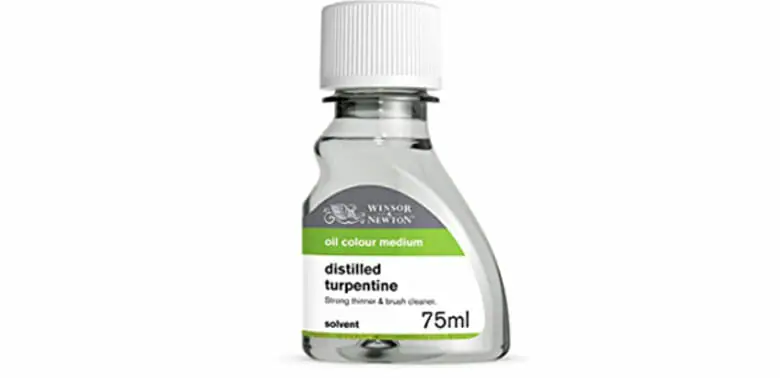
Odorless Mineral Spirits (Oms)
Many artists use odorless mineral spirits (OMS), commercially known as Gamsol. OMS releases fewer fumes than turpentine and traditional mineral spirits and evaporates just as quickly, making it ideal for under-paintings and cleaning oil paint brushes.

Spike Lavender Oil
Spike Lavender Oil is the only 100% non-toxic thinner. True to its name, this solvent smells strongly of lavender; it also dries fast – at a rate similar to turpentine – and intensifies paint colors. It leaves a smooth, matte finish and can even be used to blend colored pencils. Frugal artists, take note: this is usually a pricier option.

Citrus Solvents
Some artists use a citrus solvent like Real Milk Paint, which works like turpentine or mineral spirits without the fumes. The Real Milk solution is 2% water and 98% pure citrus peel oil, but don’t worry – it’s not orange (although it smells like it)! It comes out clear and dries matte, and it’s easy on your budget and the environment.
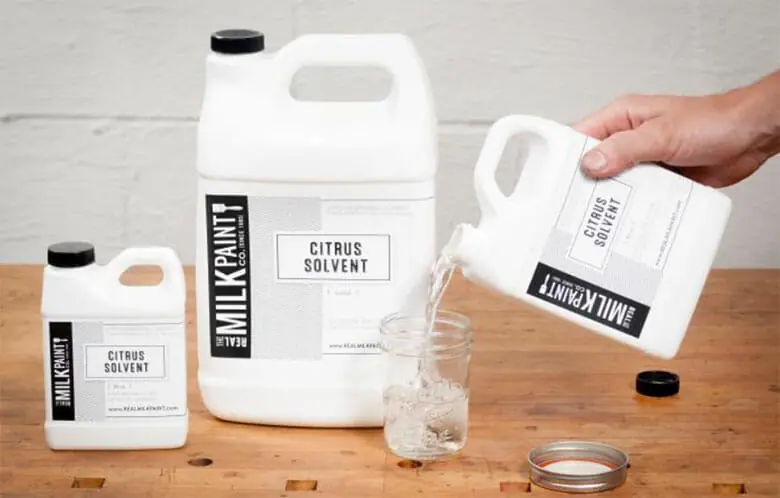
How to Use Solvents Safely
While some artists still use turpentine or mineral spirits to thin oil paint, these thinners can irritate the skin and even affect the central nervous system if inhaled over time. When using a toxic solvent, ventilation should be your #1 priority.
Prop any windows open, keep the fan system running, and invest in a box fan if possible. Any rags or palette paper used with thinners should be stored in an airtight jar in a cool, dark space. If it’s difficult to keep your space well-ventilated, choosing less toxic thinners or painting solvent-free (more on that later!) is the most sustainable option.
How to Thin Oil Paint With Solvents
There’s no consistent ratio for solvent to paint, but many artists start with a 1:1 or 1:2 ratio of paint to solvent. When layering oil paint, you’ll add more solvent to the first layer, then gradually reduce the amount used for the upper layers.

Most artists start by pouring a small amount of solvent into a jar with a tight-fitting lid, which prevents sneaky solvents from evaporating into your studio.
Whichever solvent you choose, remember that a little bit goes a long way. Take your brush, dip it into the solvent jar, then mix it into your paint palette – then close the jar lid! Continue to do this until you’re satisfied with the consistency of the paint. Because solvents can be harsh on brushes, some artists use a palette knife for this step.
The initial layers are painted with solvent. When the solvent evaporates, it leaves a dry, speckly-looking surface.
Thinning with Mediums
“Wait! What’s a medium?”
Great question – and one that’s easily glossed over in art school. An oil paint medium is an oil-based substance that changes the viscosity, surface finish, or drying time of oil paint. Some mediums can also be used as thinners, such as:
Gamblin Galkyd
Galkyd is a fast-drying, petroleum-based medium that makes paint “flow” on a canvas and adds a lovely gloss.
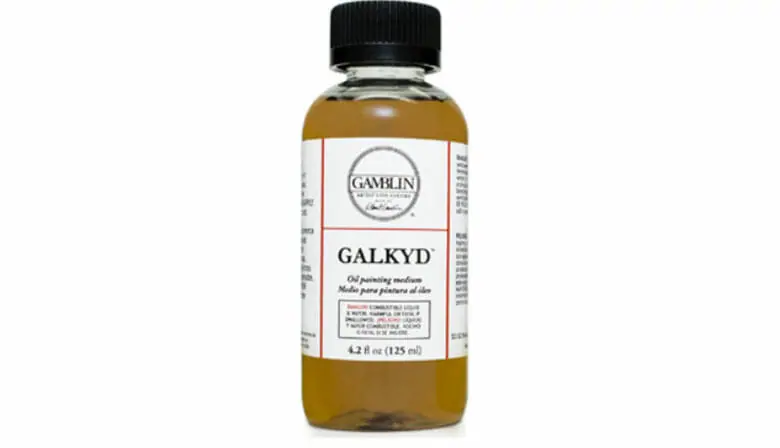
Liquin
Liquin is an alkyd medium, which is a synthetic resin treated with alcohol and acid. It comes in five thicknesses for varying effects and speeds up the drying process by roughly 50%. Note that alkyds are much weaker solvents and dry more slowly than traditional thinners.
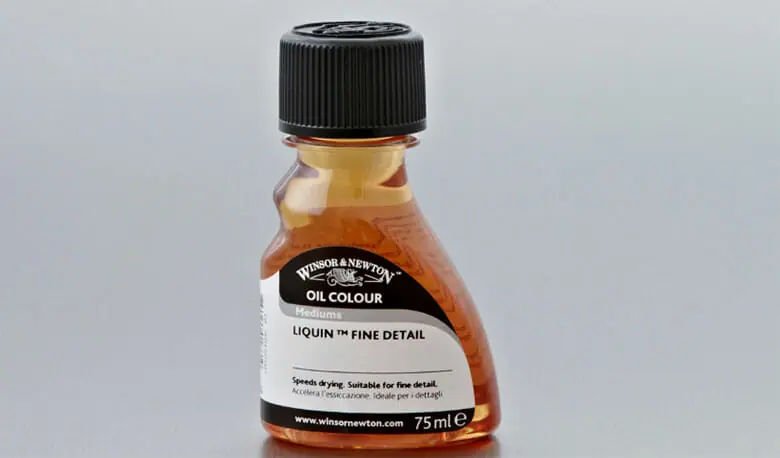
How to Thin Oil Paint with Mediums
To start with, simply pour out some medium into a small jar, or even the container’s bottle cap to minimize waste. Then, dip a small brush and mix the medium into the paint on a palette. If you abide by the Fat over Lean rule (more on that soon) and use solvents as well, you’ll start to add mediums in the mid-to-upper later layer.
Some painters used a small amount of medium for painting thick, visible brushstrokes: a process known as impasto painting. Others mix more medium into their final layers of paint to create a glaze. However they’re used, mediums add depth and body to any painting.
Thinning Oil Paint With Oils
Similar to a medium, a natural drying oil will increase the gloss and fat content of oil paint. Here are some of our favorites:
Linseed Oil
Linseed oil makes oil paint oilier and glossier and extends the drying time.

Stand Oil
Stand oil is basically re-heated linseed oil: it’s paler, more viscous, and will make your paintings extra glossy. Unlike linseed oil, it won’t add that yellow tint!
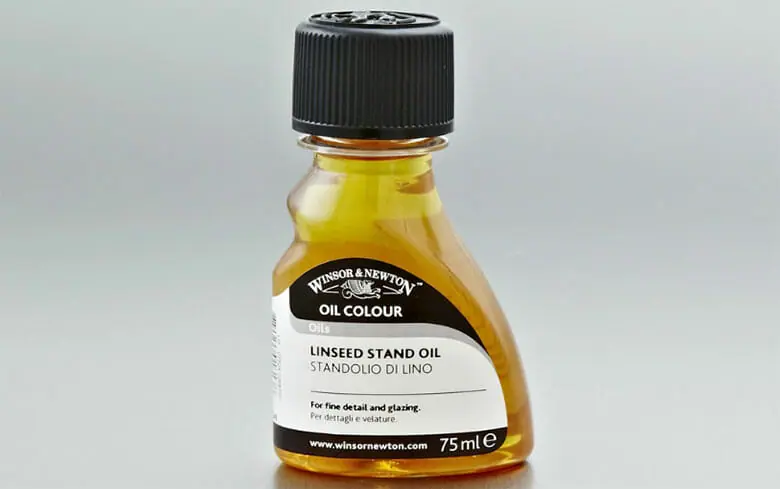
Walnut Oil
Walnut oil functions similarly to linseed oil but dries slower. It’s best for an additional layer to finalize your painting.

Poppy Oil
Like other natural oils, poppy oil is used to dilute and increase the dry rate. It’s also non-yellowing, so it works well with pale colors that are easily discolored.
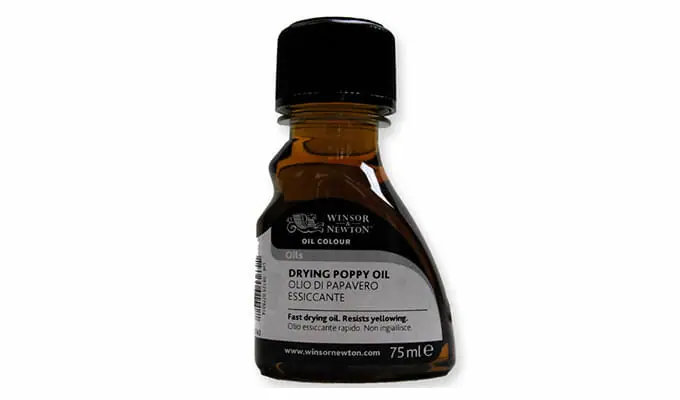
Safflower Oil
Safflower oil is very similar to poppy oil – it just dries a bit faster.

How to Thin Oil Paint With Oils
With any of these drying oils, you only need to dip the tip of your brush in the oil. Similar to mediums, you can pour a small amount into a plastic bottle lid, then transfer a small amount to your palette with a brush or palette knife. Depending on which drying oil you choose, remember that the curing process – how long it takes your painting to dry – will vary.
Thinning Oil Paint With Gels
Gels are much more viscous, or thicker, than turpentine, mineral spirits, and most mediums. Even so, any of the following gel mediums can actually be used as a paint thinner:
Maroger Medium
For years, master artists have used maroger medium to thin paint. This unique gel preserves your original paint strokes while adding a beautiful gloss.

Neo-Megilp
Neo-Megilp is the less toxic form of maroger medium. It increases the transparency and flow of oil paints and gives a smooth, silky feel to each brushstroke.

Solvent-Free Gel Medium
This solvent-free option is perfect for artists who prefer thinning paint with a non-toxic gel.

Epoxide Oil Gel
This epoxide gel won’t thin your oil paints as significantly as other gel mediums; but if you need to do a quick paint job, it decreases drying time and increases transparency.

How to Thin Oil Paint With Gels
Similar to solvents and mediums, you can use a brush or palette knife to mix a small amount of gel into your oil paint, which will increase its transparency and flow.
Remember the Fat Over Lean Rule
Let’s bring it all together! Lots of artists utilize solvents, mediums, and gels in a single painting session. For example, some painters use a combination of linseed oil and Gamsol to optimize the thinning properties of the solvent and the binding power of linseed oil.
Whichever thinner you choose, to ensure the longevity of your painting, it’s important to follow the fat-over-lean rule.
Here’s what you need to know about this classic rule of thumb (or brush):
- Thin or “lean” paint is mixed with a solvent such as turpentine or mineral spirits. These layers are matte and less oily, so they’ll dry faster.
- “Fat” paint is mixed with more oil or oil-based mediums, such as Galkyd. These layers are glossier and take longer to dry.
- The first layers should be leaner or mixed with more solvent. The upper layers should be fatter since painting with more oil takes longer to dry.

Whether you work best with solvents, linseed oil, walnut oil, or other thinning agents, always remember this rule – especially if you work in many layers. If you apply a leaner layer over an oily surface, the oilier layer will “seal” before it’s dry. Over time, this may cause the painting surface to crack.
Do Oil Paints Need to Be Thinned?
Oil paints do not need to be thinned! Painters love talking about the concoctions they’ve created for thinning oil paint, but you should work with whichever materials feel the most manageable and safe.
Professional painter Chris Fornataro recommends that beginners start with a basic paint thinner like Gamsol before adding mediums to the mix, as they can be especially finicky for amateurs.
How to Paint Solvent-Free
To avoid the safety concerns associated with turpentine and other thinners, some painters work straight from the tube. You can add a small amount of medium in each new layer to help the paint flow; or, if you want to avoid all chemical additives, try water-based oils. You can also brush a thin underlayer using regular oils and a large, sturdy paintbrush.
Can you thin oil paint with water?
Oil paint can only be thinned with water if you’re using water-soluble oils. In the past, I’ve used the Georgian water-soluble oil brand, which replicates the experience without the fumes!
What’s Next?
If you’re completely new to oil painting, we’d recommend starting with Gamsol. Many consider it the best paint thinner for oil paint because it is odorless, studio-safe, and can even be used to clean brushes. It’s ideal for beginners who don’t have a large budget or ventilated studio space.
When learning how to thin oils, we encourage artists to simply play with the materials. Get out your solvents, mediums, and your favorite brush or palette knife, and spend an afternoon (or a lifetime) trying out these techniques. Solidifying the foundations of painting is crucial for long-term creative success.
